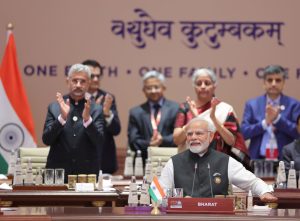When leaders of some of the world’s most important economies met in New Delhi this week for their annual G-20 Leaders’ Summit, expectations for a consensus were low. Throughout the entire year, the G-20, riven by discord and disagreements over the war in Ukraine, had been unable to agree on a joint statement at any of its many ministerial meetings. Russia’s President Vladimir Putin and China’s President Xi Jinping had both made themselves absent for the Leaders’ Summit.
Yet, against the odds, the G-20’s leaders managed to somehow hammer out a joint declaration over the weekend, buoyed by India’s passionate quest for common language.
By the nature of that compromise, the joint statement didn’t reflect any changes in the positions of the many warring geopolitical factions on Ukraine. But it did importantly help highlight the fact that the international community can put Ukraine aside in order to find some common ground on other global matters.
Perhaps just as much, it also helped rescue the G-20 from total paralysis. “Let’s say you had no G-20 statement,” one European Union official conjectured. “Newspaper headlines would say the G-20 is finished, and they would be right… So, in a way, by having a statement [we] keep the platform and the organization alive.”
Analysts in New Delhi touted the joint statement as a win for Indian diplomacy, which worked admirably to find common minimum ground within a raucous group. India also made history by presiding over the long-awaited inclusion of the African Union as a permanent member – a symbolic boost for New Delhi’s credentials as a leader in the developing world.
But the more significant wins of the summit came from outside the meeting halls.
For years, India’s foreign policy has been a forgotten side note in the country’s domestic political discourse. Foreign affairs are rarely debated or discussed – either during election campaigns or on prime time television – and governments and prime ministers have rarely ever been elected for their foreign policy prowess.
At the launch of my 2021 book, “Flying Blind: India’s Quest for Global Leadership,” Indian MP and former U.N. diplomat Shashi Tharoor argued, “Foreign policy is too critical an issue for the well-being of the people in the country to be confined to the chancelleries of New Delhi, the embassies and the South Block [of Parliament, where the Ministry of External Affairs sits].”
That changed over the last several months with India’s G-20 presidency. In a bid to showcase India’s leadership, Prime Minister Narendra Modi led an aggressive marketing drive to advertise the G-20’s meetings with hoardings across the country.
In total, as many as 60 Indian cities will have hosted a G-20 meeting this year, from Srinagar in the north to Thiruvananthapuram in the south, and from the Rann of Kutch in the west to Guwahati in the east. In the run-up to the Leaders’ Summit this weekend, Indian news channels were shockingly inundated with important debates over India’s role in the developing world, the lingering problem of debt crises, and how India ought to shape norms in emerging areas such as artificial intelligence.
Yet, with that unprecedented limelight, there also comes scrutiny of other, less flattering matters.
In a controversial drive to “beautify” New Delhi for the summit, authorities razed ramshackle homes belonging to thousands of poor families living in the city’s slums. That development added to a more recent trend, which has seen authorities across India demolish houses overnight following protests and communal incidents.
The swiftness with which those actions have been taken, without much recourse to residents, has triggered concerns over whether any due process was being followed. In July last year, a petition was filed before the Supreme Court, asking for a stay on the demolition of properties. The court voiced concerns over the rule of law but ultimately refused the petition.
It wasn’t always so easy to demolish properties in India. In his 2009 book “The Post-American World,” columnist Fareed Zakaria compared India with China by pointing out how the Chinese government was able to clear out entire neighborhoods overnight with few questions asked. “India does not have a government that can or will move people for the sake of foreign investors,” Zakaria wrote. “The country’s key advantages are a genuine private sector, established rights of property and contract, independent courts, and the rule of law.”
These rapid changes are now being capped off by a rumored name change for the country itself. Ahead of the G-20 summit in New Delhi this weekend, dignitaries were invited to a dinner with the “President of Bharat” — a name for India that is often used in Hindi but almost never in English. Modi later sat at the summit himself with a nameplate that read “Bharat” instead of the usual “India.”
The more frequent use of “Bharat” to refer to the country has long been a demand of Hindu nationalists who feel that the word “India” is of foreign origin. A compromise was struck by the Constituent Assembly in the 1940s by including the word “Bharat” as an alternative name for India in Article 1 of the Constitution. But as India then tried to straddle between West and East, English and vernacular, and modern and traditional, that term was never used in English communication.
The balancing act between those contrasting worlds has now been discarded by New Delhi, further solidifying a shift in India’s national identity – based more firmly on ethnic nationalism than on the looser, more inclusive, globalized identity of the past.
India has changed on several fronts – both for better and for worse. Much of that change was on display this weekend as the G-20 met in New Delhi.

































